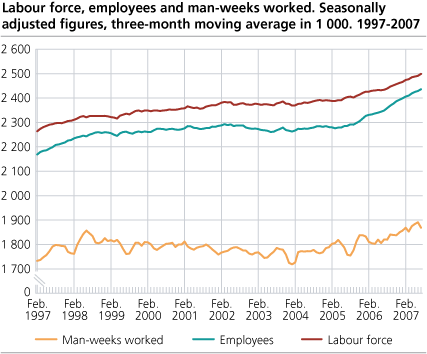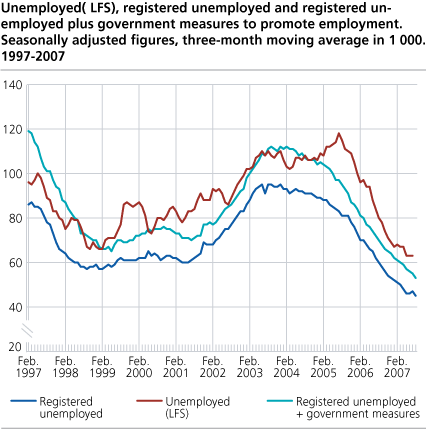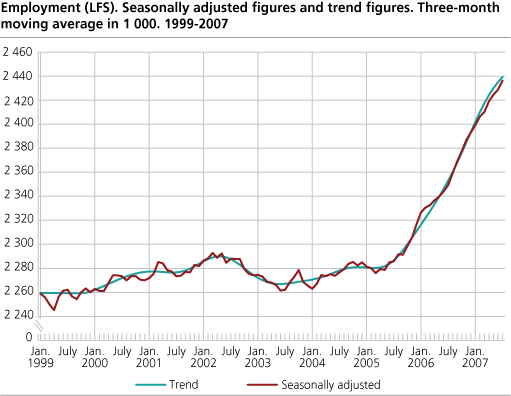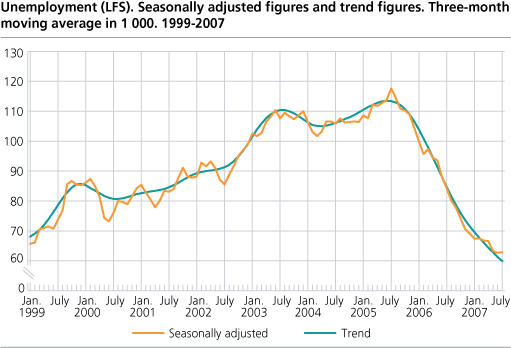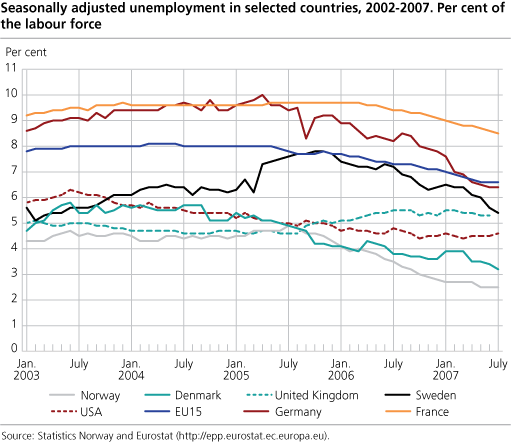Content
Published:
This is an archived release.
Continued rise in employment
Employment increased by 17 000 from April to July 2007.
Adjusted for seasonal variations, the Labour Force Survey (LFS) shows that the number of employed increased by 17 000 or 0.7 per cent from April (as measured by the average of the three months from March to May) to July (as measured by the average of the three months from June to August).
Unemployment nearly unchanged
The unemployment rate stood at 2.5 per cent of the labour force in July (as measured by the average of the three months from June to August), compared with 2.7 per cent in April (as measured by the average of the three months from March to May). The 0.2 percentage points decline (4 000 people) is inside the LFS error margin. Seasonally adjusted figures of people registered unemployed and on government measures to promote employment with the Labour and Welfare Organisation (NAV) show a decline of 4 000 in the same period.
Man-weeks worked
From April (as measured by the average of the three months from March to May) to July (as measured by the average of the three months from June to August) the average number of man-weeks (37.5 hours) worked each week decreased by 6 000 adjusted for seasonal variations. This is inside the LFS error margin.
Unemployment down in Sweden and Denmark
The unemployment rate in Sweden fell from 6.1 per cent in April to 5.4 per cent in July and in Denmark the unemployment rate fell from 3.5 per cent to 3.2 per cent in the same period. In France, the unemployment rate fell from 8.8 per cent to 8.5 per cent. According to provisional figures, Germany saw unemployment drop from 6.6 per cent in April to 6.4 per cent in July. The unemployment rate for the EU15 fell from 6.7 per cent to 6.6 per cent in the same period. The US saw an increase in unemployment from 4.5 to 4.6 per cent. (All figures refer to seasonally adjusted data from Eurostat .)
Employment and unemployment figures include permanent residentsThe LFS only includes persons who are registered as residents in the population register. Persons working in Norway, but who are not registered as permanent residents or who are planning to stay for less than six months, are not included in the number of employed in the LFS. Some of these will later become registered residents and then be included in the population covered by the LFS. Statistics Norway publishes separate figures for registered non-residents once a year. See short-term immigrants . |
Uncertain figuresThe purpose of making adjustments for seasonal variations is to describe the development over the last year and provide estimates of change between the last two three-month periods, corrected for normal seasonal variations. In order to reduce uncertainty, the published series are three-month moving averages of the seasonally adjusted figures. For instance, the figures for February represent the average of the estimates for January, February and March. Quarterly LFS figures, not seasonally adjusted, are presented in a separate article . |
Tables:
The statistics is published with Labour force survey.
Contact
-
Arbeidsmarked og lønn
E-mail: arbeidsmarked@ssb.no
-
Erik Herstad Horgen
E-mail: erik.horgen@ssb.no
tel.: (+47) 93 08 68 62

